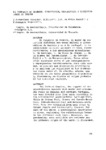El complejo de Órdenes: subdivisión, descripción y discusión sobre su origen.

View/
Use this link to cite
http://hdl.handle.net/2183/5862Collections
Metadata
Show full item recordTitle
El complejo de Órdenes: subdivisión, descripción y discusión sobre su origen.Date
1984Citation
Cadernos do Laboratorio Xeolóxico de Laxe, 1984, 7: 139-210 ISBN: 84-7492-204-6
Abstract
[Resumen] El Complejo de Ordenes, el mayor de los macizos alóctonos con rocas máficas y ultramAficas de Galicia y el N de Portugal, se ha subdividido en cinco unidades en base, fundamentalmente, a las asociaciones litológicas: U. de Santiago, U. de Villa de Cruces, U. De la Sierra del Careón-Bazar, U. de SobradoMellid y U. de Betanzos-Arzúa. Todas ellas están separadas entre si por cabalgamientos y superpuestas tectónicamente. Para cada unidad, se realiza una descripción petrológica y se analizan las relaciones de las diferentes rocas entre si. ,Se efectúa, además, una revisión de los datos geoquimicos disponibles y, finalmente, se discute el origen probable de las distintas unidades [Abstract] The Ordenes Complex, the biggest OI the allochthonous massifs with mafic and ultramafic rocks in Galicia and northern Portugal, has been divided into five units according to the lithological associations: Santiago Unit, Villa de Cruces Unít, Sierra del Care6n-Bazar Unit, Sobrado-Mellid Unít and BetanzoS-Arzúa Unít. They are separated from each other by thrust faults and tectonically stacked. For each OI the units, a petrological description is given, explaining the relationships between the different rock types. Moreover, the geochemical data available are reviewed and the probable origin of the units is discussed
ISBN
84-7492-204-6





